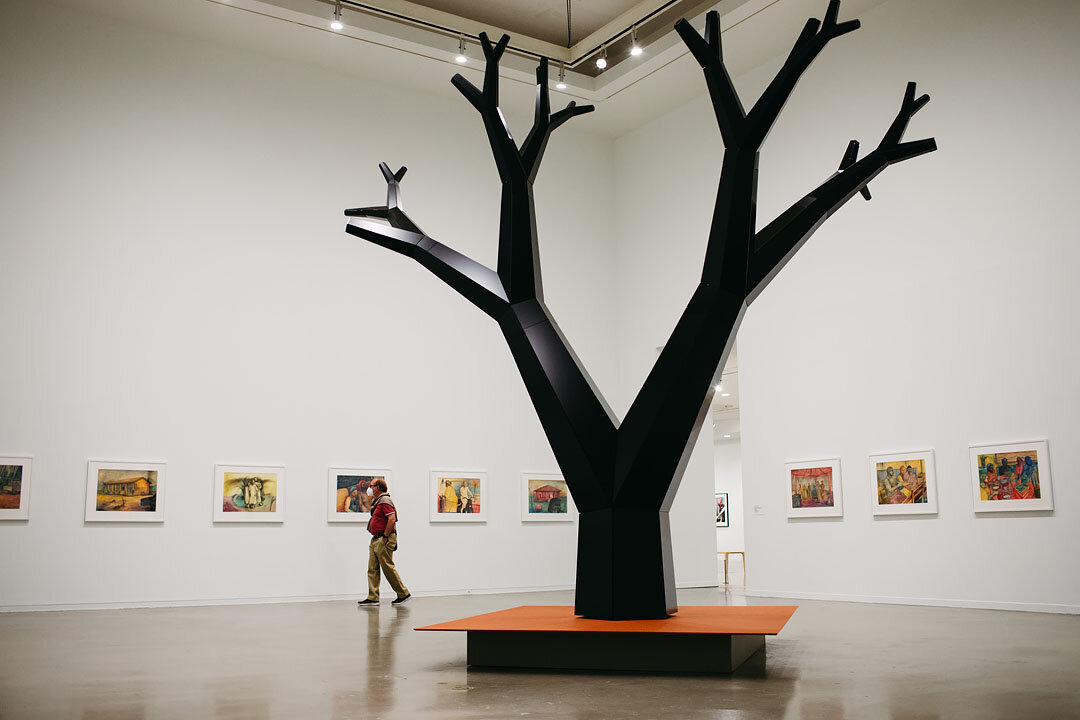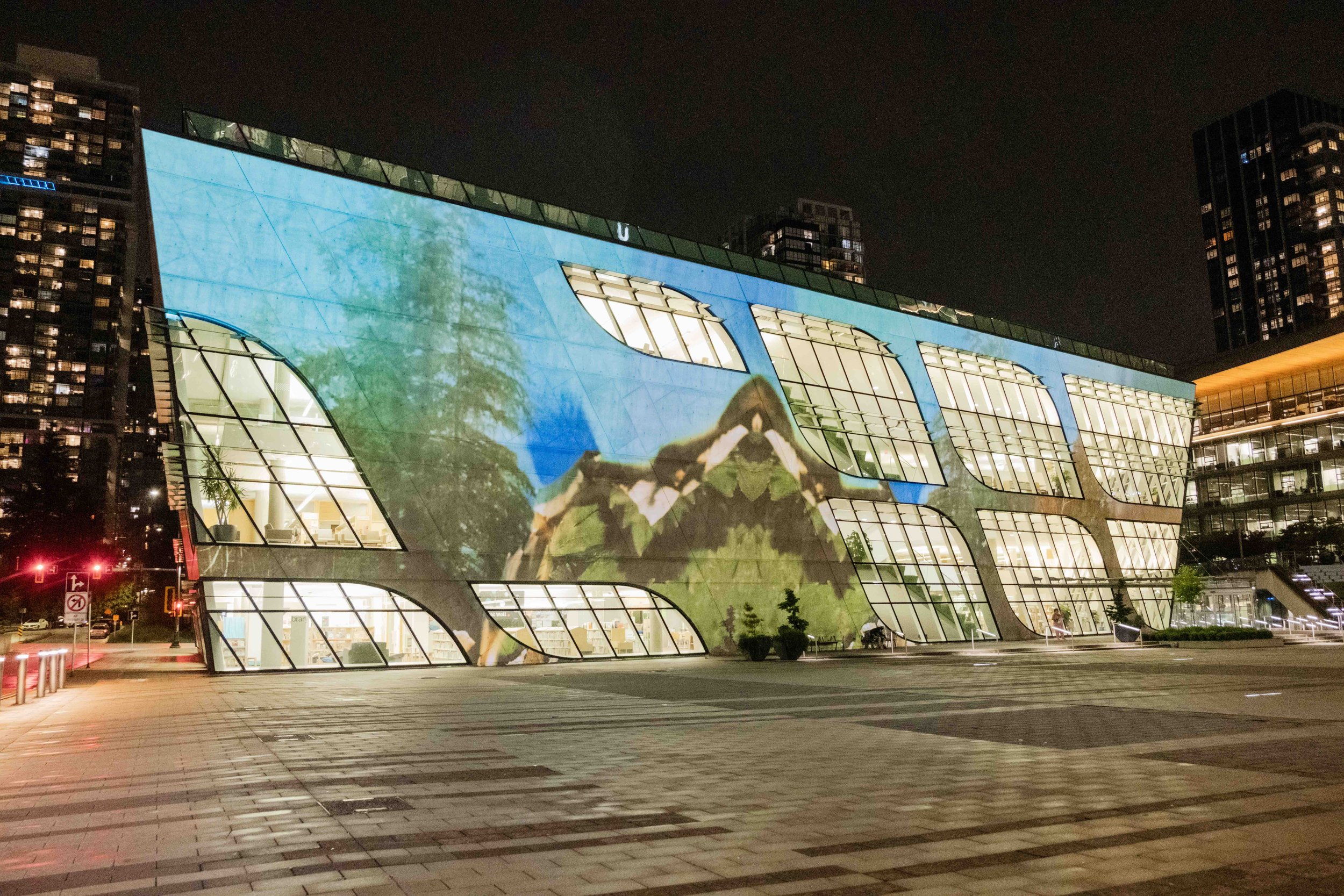VAG's vast Vancouver Special: Disorientations and Echo exhibition amplifies diverse new voices on the local scene
Seeing in new ways, with broken-and-rebuilt ceramics to room-filling tree sculptures, textiles, and murals
Marika St. Rose Yeo’s Shifting Conversation Series IV, Vessel 2. Photo courtesy of the artist
Marika St. Rose Yeo’s Shifting Conversation Series II, Vessel 3. Photo courtesy of the artist
Installation view of Charles Campbell’s Tree: Finding Accompong. Photo by Scott Little
Vancouver Art Gallery presents Vancouver Special: DIsorientations and Echo until January 2
AN ENTIRE ROOM in Vancouver Special: Disorientations and Echo is filled with exquisite ceramic vessels that have been broken and then glued meticulously back together again.
Off-kilter, wobbly, and crumpled, their carved patterns now fractured into a crazy-quilt mosaic, Marika St. Rose Yeo’s vases stand on plinths spaced out across the floor.
They become a perfect metaphor for an expansive new exhibit that brings together fragmented heritages—those of 32 mostly BIPOC local artists over a vast range of media.
Despite their fragility, there’s an underlying resilience to Yeo’s “Shifting Conversations” ceramics series. Look closely and you’ll see that the urn- and vase-like forms—as well as their surfacepatterns of lines, leaves, flowers, and geometric shapes—reference ceramic and textile design in the Caribbean, West Africa, and Western Europe.
“One thing that Marika is really interested in are the traces of things that are left behind,” says one of Vancouver Special’s curators, Phanuel Antwi, a poet, writer, and assistant professor of English at UBC, at the opening media tour. “She's trying to think about this coming-together of histories and of materials. And for her, she is interested in the way that broken things are actually not incomplete: there’s a way that she's working through fragments and pieces.”
Creating the vessels, Yeo was inspired by a quote from a Nobel Prize in Literature lecture by West Indian poet and playwright Derek Walcott, who wrote, “Break a vase and the love that reassembles the fragments is stronger than that love that took its symmetry for granted when it was whole....This gathering of broken pieces is the care and pain of the Antilles, and if the pieces are disparate, ill-fitting, they contain more pain than their original sculpture, those icons and sacred vessels taken for granted in their ancestral places.”
Walcott was speaking specifically about his Caribbean roots, but his words, and Yeo’s sculptures, capture the thrust behind the new VAG exhibit—a wide survey of the some of the most exciting new art being created in Greater Vancouver.
The second in a series of Vancouver Special shows that take a wide look at local art—the first one, subtitled Ambivalent Pleasures, took place five years ago—the exhibition reflects a new, more inclusive approach by the institution. “The exhibition itself acknowledges the VAG’s own shortcomings and the desire to be more inclusive going forward,” explains Grant Arnold, the VAG’s Audain Curator of British Columbia Art.
With that in mind, Arnold was joined by three other Vancouver-based guest curators who brought the show to fruition: Jeneen Frei Njootli, visual artist, curator, and assistant professor at the University of British Columbia; Jenn Jackson, author and independent curator; and Christian Vistan, a visual artist and independent curator.
Initially, 2021’s Vancouver Special was envisioned as having the curators work independently and make their own selections. “But as we discussed the exhibit and what it could be...we realized it could be stronger if we worked as a collective,” Arnold says.
The resulting array of work includes major, room-filling pieces and significant series by artists who you may never have heard of before—or who haven’t shown at the city’s biggest gallery.
Like Yeo’s “Shifting Conversations”, a lot of the works on display weave together multiple histories, creating a rich and complex view of this place at this time.
Setting the tone early on is Lauren Brevner and James Nexw’Kalus Harry’s awe-inspiring, giant wall mural Rememory. Specially commissioned for the show, it features a strong matriarchal figure flanked by stylized Salish Woolly Dogs and Okinawan Shisa. Its designs also refer to textiles and weaving, drawing on Brevner and Harry’s respective Japanese-Trinidadian and Indigenous heritage. Rememory bathes the viewer in rich hues of blue, set off by intricate copper leaf.
Installation view of Lauren Brevner and James Nexw’Kalus Harry’s Rememory. Photo by Scott Little
Echoing those cerulean tones in the same room are Punjabi Canadian artist Simranpreet Anand’s hanging fabrics. She made ਦਸਤਾਰ ਬੰਨ੍ਹਣ ਲਈ ਬਲੂਪ੍ਰਿਪੰਟ (blueprints for tying a Dastaar) by treating the white turban (or dastaar) fabric with photosensitive cyanotype chemicals, tying it in different styles she learned from family and friends, and exposing the fabric to sunlight to create indigo streaks and spots. Suspended from the ceiling, they become textile artworks deeply connected to tradition, culture, and the person who wore them.
Dominating another vast room is Jamaican-born, Victoria-based Charles Campbell’s giant Tree: Finding Accompong—a black sculpture whose branches stretch toward the ceiling in forms that evoke not just slave yokes (the forked wooden sticks once used to tie captives together) but also the pathways of the respiratory system. The title refers to the historical Jamaican village of Accompong, where 18th-century Maroons (Africans who had escaped slavery) would meet and organize themselves under a large Kindah tree. The sculpture is at once stark and sinister yet hopeful, connecting symbols of oppression to those of nature and life. (The visual allusion to airways also provokes inescapable thoughts of 2020’s “I can’t breathe”, the cry that sent Black Lives Matter protestors into the streets.) In the way that it refers to healing and regeneration in the face of a racist past, it connects beautifully with Yeo’s vessels.
Installation view of Patrick Cruz’s si mabait at si malihim, mga agam agam sa kuro kuro. Photo by Ian Lefebvre
A few steps through a doorway and you enter the dizzying labyrinth of Patrick Cruz’s room-filling si mabait at si malihim, mga agam agam sa kuro kuro. The Filipino Canadian artist who plays with folk-art influences, memories of his homeland, and themes of belonging mashes together endlessly reworked canvases—integrating handwritten notes, doodles, and huge layered splashes of tropical colour. They hang from the ceiling; sometimes a row of shoes pokes out from beneath them. At the back of the room, a soundtrack inspired by Filipino AM radio emanates from a mousehole. It’s playful, disorienting, and multilayered.
There is more, much more, to surprise, provoke thought, and confound in a show that is ultimately a lot about discovery—often of the talent we have in our own back yard. Other highlights include 2-spirit artist Manuel Axel Strain’s striking large-scale paintings that distort and recast art-historical images of women from an Indigenous, nonbinary point of view; Yaimel López Zaldívar’s meditative and dreamlike mixed-media-on-paper reinterpretations of his wife’s old photos of a trip to Benin; NuZi Collective member Betty Mulat’s large-scale staged photographs exploring Black female identity, inspired by magazine shoots; and Philadelphia-born Jim Adams’s Pop-inflected acrylic paintings about urban America.
The ideas and histories continue outside the doors of the VAG. Among the pieces installed on the façade as part of Vancouver Special is a huge new banner by Carrier Wit’at artist Whess Harman. Called the lowest bar, it hangs from, and reclaims, the building’s colonial facade.
The Emily Carr University grad and grunt gallery curator’s banner may at first appear to be written in some lost Coastal language, rendered in bright graffiti-meets-formline script and comic-book hues.
“As we spend time looking at this work, words start to emerge,” suggests Njootli. “They talk about how it is intentionally challenging to read, or is unreadable...It might at first seem Northwest Coast, and as we begin to decipher, this other form of meaning starts to emerge.”
A lot of the works at the 2021 Vancouver Special exhibit take similar time to find shape and meaning. Like so many of the pieces here, the show tries to teach us to see differently—and to piece together a fuller picture of this place, and our world.

















